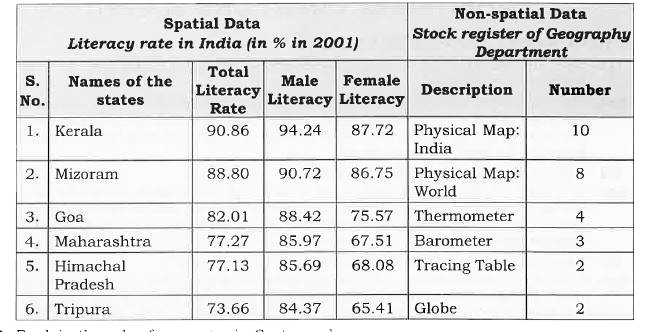Differentiate between Spatial and Non-spatial data.
The spatial data are characterised by their positional , linear and areal , forms of appearances . The data describing the information about spatial data are called as non-spatial or attribute data . In other words, you will be defining the attributes of the spatial data . Thus , non-spatial data are also known as attribute-data .

Topper's Solved these Questions
- SPATIAL INFORMATION TECHNOLOGY BOOK - FULL MARKSCHAPTER - SPATIAL INFORMATION TECHNOLOGY EXERCISE - ADDITIONAL QUESTIONS SOLVED (III. LONG ANSWER QUESTIONS)
2 Videos
- SPATIAL INFORMATION TECHNOLOGY BOOK - FULL MARKSCHAPTER - SPATIAL INFORMATION TECHNOLOGY EXERCISE - ADDITIONAL QUESTIONS SOLVED (IV. VIVA - VOCE QUESTIONS )
6 Videos
- SPATIAL INFORMATION TECHNOLOGY BOOK - FULL MARKSCHAPTER - SPATIAL INFORMATION TECHNOLOGY EXERCISE - ADDITIONAL QUESTIONS SOLVED (I. VERY SHORT ANSWER QUESTIONS)
6 Videos
- SECONDARY ACTIVITIES BOOK - FULL MARKSCHAPTER - SECONDARY ACTIVITIES EXERCISE - WORKSHEET (BASED ON CHAPTER-6)
7 Videos
- THE WORLD POPULATION DISTIBUTION, DENSITY AND GROWTH BOOK - FULL MARKSCHAPTER - THE WORLD POPULATION DISTIBUTION, DENSITY AND GROWTH EXERCISE - WORKSHEET
15 Videos
Similar Questions
What is the difference between spatial and non spatial data? Explain with examples.
View SolutionDifferentiate between data and information.
View SolutionWhat is Non-spatial data?
View SolutionDifferentiate between metal and non-metal on the basis of their chemical properties.
View SolutionDifferentiate between metals and non-metals on the basis of their chemical properties.
View SolutionDifferentiate between metal and non-metal on the basis of their chemical properties.
View SolutionDifferentiate between metal and non-metal on the basis of their chemical properties.
View SolutionDifferentiate between metal and non-metal on the basis of their chemical properties.
View SolutionDifferentiate between metal and non-metal on the basis of their chemical properties.
View SolutionDifferentiate between metals and non-metals on the basis of sonorosity.
View Solution
